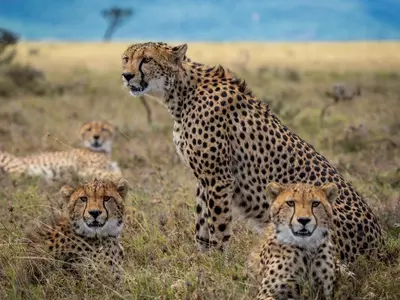Explained: Why Cheetahs Are Being Brought Back To India After 1952

The Indian government is all set to bring cheetahs from South Africa to Madhya Pradesh’s Kuno-Palpur National Park by August this year. They are the only large carnivore that is completely extinct in India due to overhunting and habitat loss primarily.
Under the 'Action Plan for Introduction of Cheetah in India’, the Indian government is reintroducing cheetahs in India which will help the ecosystem as the animal lives in open plains like grasslands, and scrubs and open forest systems etc.
Action Plan for Introduction of Cheetah in India
 TOI/Representational Image
TOI/Representational Image
The Indian government is reintroducing cin India, under the Action Plan for Introduction of Cheetah in India. Union Minister for Environment, Forest and Climate Change Bhupender Yadav informed that “Project Cheetah aims to bring back independent India’s only extinct large mammal – the cheetah. As part of the project, 50 cheetahs will be introduced in various National Parks over five years.”
About 10 sites in the central Indian states were surveyed, of which Kuno Palpur National Park (KNP) in Madhya Pradesh got the highest rate. With a 748 sq. km area, KNP has no human settlements and is a suitable habitat with a sufficient prey base for cheetahs. Further, KNP forms part of Sheopur-Shivpuri deciduous open forest landscape and is capable to sustain 21 cheetahs.
The other sites recommended for holding and conserving breeding of cheetah in India include Nauradehi Wildlife Sanctuary, MP, Gandhi Sagar Wildlife Sanctuary – Bhainsrorgarh Wildlife Sanctuary complex Shahgarh bulge in Jaisalmer, Rajasthan etc.
Where the Cheetahs are coming from?
Iran is the home to the locally extinct cheetah subspecies of India. They are placed under the critically endangered category. During such conservation efforts, it should be kept in mind that the sourcing of animals should not be detrimental to the survival of the source population.
 TOI/Representational Image
TOI/Representational Image
India will be sourcing Cheetahs from Southern Africa because it is impossible to source Asiatic cheetahs from Iran without affecting these sub-species.
Further, Cheetahs from Southern Africa are ancestral to all the other cheetah lineages including cheetahs found in Iran.
Cheetah in India
Due to hunting and habitat loss majorly, the cheetahs have gone extinct in India. In 1952, the government of India officially declared the extinction of the Cheetah in the country. However, reportedly rare sightings of the species happened until 1970.
 TOI/Representational Image
TOI/Representational Image
According to the historical records, the last three recorded Cheetahs in India were considered to be killed by Maharaja Ramanuj Pratap Singh Deo of Korea, Madhya Pradesh in 1947.
Even today, a number of rosette-covered cats are mistaken as cheetahs by many people but are entirely extinct in India. With limited to less than a hundred, the Asiatic Cheetahs are only found in Iran.
While the world's majority of Cheetah population is found in Southern and Eastern Africa, and the African Cheetah is found in countries like South Africa and Namibia.
How did Cheetah extinct in India?
In India, the earliest available record for Cheetah hunting is found in the 12th-century Sanskrit text Manasollasa produced by the Kalyani Chalukya ruler, Someshvara III. 'Cheetah' name comes from Sanskrit which means 'the spotted one'.
 TOI/Representational Image
TOI/Representational Image
The Indian Cheetahs were in abundance during the Mughals period. In fact, Mughal Emperor, Akbar reportedly had over 9,000 cheetahs alone. The animals were used to hunt prey in a sport called 'coursing’. Further, nobilities and royals used to hunt the animal for sport-hunting and Cheetah was easy prey as compared to tigers.
Over-hunting during the British rule caused the extinction of this animal and experts also suggest that the Cheetah has enough habitat and prey population to survive but hunting led to the extinction
Cheetah cannot breed in captivity and this resulted in a fall in its population even before the British rule. The Britishers also cleared forests extensively for cultivation and habitation. Thus, the animal faced a huge loss in their habitat.
For more on news and current affairs from around the world please visit Indiatimes News.

























